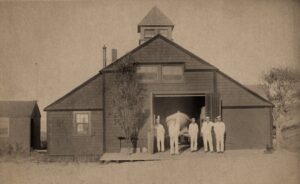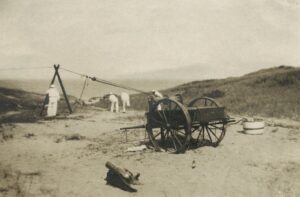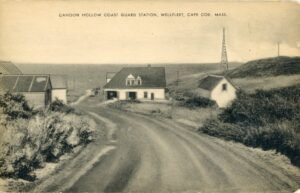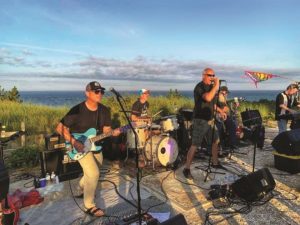The Cape Cod Oracle of Thursday, March 17, 1988 included a letter to the editor from Lawrence H. Gallagher, the younger brother of Russell Gallagher. In 1953, Russell had purchased the old lifesaving station at Cahoon Hollow Beach in Wellfleet and turned it into an inn called the Beachcomber.

The letter was titled “Cahoon’s Hollow: Of Girls and Coast Guardsmen.” The Oracle had two weeks earlier mentioned Cahoon’s Hollow in its “Now and Then” column, with a note at the end inviting readers to write in with more information about what it was like at the station “in the ‘good old days.’ ”
“You struck close to home,” wrote Lawrence, who was born in 1916. He’d spent his first summer in Wellfleet as a child in a “hexagonal hunting lodge” on Great Pond. When his father, Roy, beached his car in the sand by the pond, a Captain Tobin came from the Coast Guard Station at Cahoon’s Hollow to pull him out, and a friendship was born.
Eventually, the captain sold his summer cottage, located next to the lifesaving station, and seven acres of oceanfront land north of Cahoon’s Hollow to Roy for $400. From 1925 on, the Gallaghers spent every summer there. As teenagers, Lawrence worked at the old Howard Johnson’s in Orleans — the original location of the franchise in the country, now the Lost Dog Pub — and Russell worked at the Pancake Man in South Yarmouth.
Lawrence, with degrees from Yale and Columbia, became a teacher and school administrator in New York, but returned to the Cape and lived in Wellfleet from 1975 to 2008. He was the assistant superintendent of the Nauset schools from 1973 to 1977 and in the ’90s served as a Wellfleet selectman. He died in November 2008 at 92; Russell died a year later at 95.
After the U.S. Life Saving Service was created in 1872, nine staffed stations were built on Cape Cod, including the one at Cahoon’s Hollow. The station replaced the Massachusetts Humane Society boat house and house of refuge erected there around 1850.

The lifesaving station had weathered shingles and a steeply sloped roof. Coast Guardsman Earle G. Rich wrote in his 1973 book Cape Cod Echoes that the stations were “crude structures by today’s standards.” The only heat, he wrote, came from “a huge Crawford No. 8 cook stove located in the galley.” The original building was destroyed by fire in February 1893 and rebuilt.
The surfmen who staffed the station were “the last of a breed,” wrote Rich. Paid $60 a month, they kept round-the-clock watch on the sea. They played “a deadly game with the elements,” he continued. “Come hell or high water and with utter disregard for their own safety, the safety of a shipwrecked sailor clinging to the rigging of some stranded vessel came above all else to them.”
“By the beginning of the 20th century,” the Independent reported in October 2024, “shipwrecks happened less often — ships were sturdier and the Cape Cod Canal provided safer passage up the East Coast.” In 1915, the Life Saving Service was incorporated into the newly formed U.S. Coast Guard.
“As I look back on that era,” wrote Rich in an article titled “The Cahoon’s Hollow Lifesavers,” published in The Summery in 1971, “I am convinced they were a happy lot.” They baked gingerbread in their oven and polished the stove every afternoon. They were careful not to spill grease on the “scrubbed rock maple floor.” Beside the hot water tank, there was room for a chair on which they left a pan with freshly kneaded dough. It would rise overnight for fresh bread and biscuits the next morning.
Decades later, in his letter to the Oracle, Lawrence Gallagher also writes of food. Returning from a patrol — he and Russell, only boys, were “faithful companions” of the surfmen — they made hot chocolate and coffee, and “grabbed huge hunks of homemade bread from the pantry drawer and smeared generous layers of peanut butter on top.”
Young Gallagher, with a spyglass, sometimes let his gaze wander from the sea. In his letter, he writes, “We got some pretty good looks at unsuspecting bathers (female, of course) who walked down the beach a few hundred yards to go skinny-dipping.”

Gallagher goes on to write that Camp Chequessett, a summer camp for girls in Wellfleet, would send the entire camp to the hollow several times each summer. “Those days were wonderful, with so many beautiful girls swarming all around us. (Many of them went skinny dipping, too!)”
Russell, a World War II veteran, operated the Beachcomber as a small inn for 25 years. Much of the decor consisted of items Russell “picked up on the beach and just sort of nailed to the wall,” says Lisa Brown, Lawrence Gallagher’s stepdaughter, who was born and raised in Wellfleet. “There was a lot of driftwood.”
In 1961, when the Cape Cod National Seashore was created, the Beachcomber Inn, now on federally protected land, was allowed to remain in operation as a pre-existing commercial use otherwise prohibited in the Park.
About the inn, Brown mostly remembers the cold. “They had crappy heating,” she said. “It was drafty. If you got a table by the fireplace, you were lucky.”
But the food was good, she says. A man named Forbes Dodge was the chef. As for the patrons who slept in the guest rooms upstairs, “I don’t know who they were,” says Brown. “They must have been hardy souls, because the wind whipped through there.”
Russell, who Lawrence writes in his letter “became interested in cranberries,” sold the Beachcomber in 1978 to its current owners, Todd E. LeBart and Hugh Dunbar, and bought some bogs in Harwich. LeBart and Dunbar turned the building into a restaurant, bar, and music venue. A statement on the Beachcomber website calls it “a little slice of seaside heaven.”
LeBart says the building has been remodeled. “We’ve kept it rustic,” he says, but all traces of its days as a lifesaving station are gone — no woodstove, no surf boats — except for the building itself.
Russell’s inn was “a wild place,” LeBart said in an article titled “Wellfleet’s One and Only,” published in the Cape Cod Times in 2015, “according to those who frequented the Beachcomber in those days.” It was “like a mini resort with guest rooms upstairs, a piano bar downstairs, and a self-serve ‘honor system’ bar that allowed patrons to make their own drinks and pay for them by placing money in a jar.”
“The Gallaghers were honorable folks,” says Brown.
There was “a hell of a lot more parking lot back then,” she says. Much of the former parking area on the ocean side of the building has been lost to erosion. Now, in the summers, parking at the Beachcomber is notoriously scarce, and shuttle buses bring patrons from other parking lots in town.
In his letter to the Oracle, Gallagher writes, “Life was quite lonesome at the station during the winter.” In the 1920s, the road to town was just sand. Later it became a shell road, then finally a paved one.
He and Russell would sometimes walk the five-mile round trip from the hollow to town. On the way back, writes Gallagher, they’d find their way through the dark on what is now Long Pond Road. Like a rose-colored echo of the surfmen of the lifesaving station who navigated the oceanside in all weather and light, Lawrence writes that he and Russell would navigate without flashlights by “observing the sand borders of the road.”

